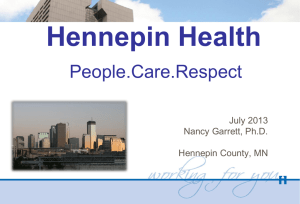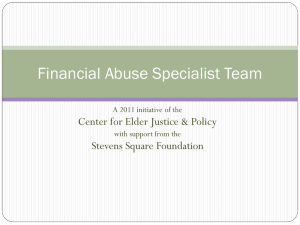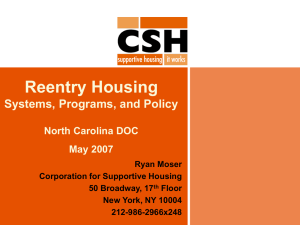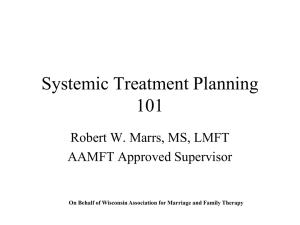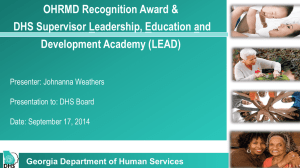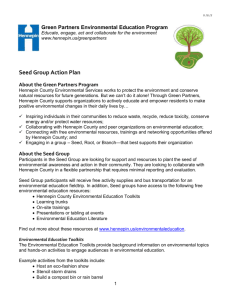Brad Kaeter, Hennepin County, MN Criminal Justice Coordinating
advertisement
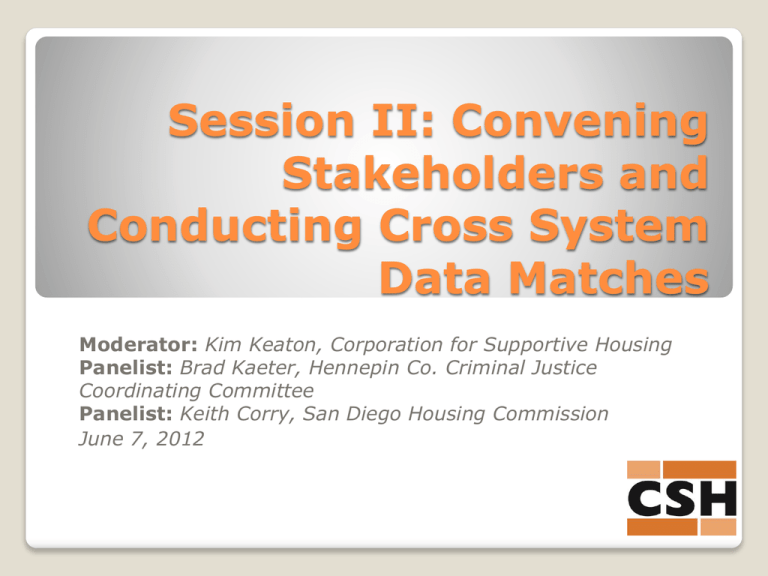
Session II: Convening Stakeholders and Conducting Cross System Data Matches Moderator: Kim Keaton, Corporation for Supportive Housing Panelist: Brad Kaeter, Hennepin Co. Criminal Justice Coordinating Committee Panelist: Keith Corry, San Diego Housing Commission June 7, 2012 Three Pillars, Nine Steps Data-Driven ProblemSolving Policy and Systems Reform Targeted Housing and Services Cross-system data match to identify frequent users Convene interagency and multi-sector working group Create supportive housing and develop assertive recruitment process Track implementation progress Troubleshoot barriers to housing placement and retention Recruit and place clients into housing, and stabilize with services Measure outcomes/impact and cost-effectiveness Enlist policymakers to bring FUSE to scale Expand model and house additional clients Identifying Stakeholders Stakeholder/ Partner Data match? County leadership (commissioners, managers, executives) Workgroup? Example Role Policy implementation and support at county levels County corrections department Data matching, program oversight, policy advocacy, service enhancement funding, facilitate jail in-reach County department of social services Data matching, program oversight, policy advocacy, service enhancement funding, facilitate shelter in-reach Local or state behavioral health agency (for frequent users of mental health services) Data matching, program oversight, policy advocacy, service enhancement funding, facilitate hospital in-reach Can commit city-specific resources such as vouchers, data (e.g. police arrest data), and overall support Provide slots in future or existing supportive housing sites, perform outreach to potential tenants, service provision Program design, assembled and coordinated funding, program oversight and troubleshooting, TA/training, State or local housing authority Provide Section 8 or other housing vouchers Foundation support Provide funding for service enhancements and evaluation City leadership partners – executive leadership, police, housing authorities Supportive housing providers CSH (where applicable) Where are the frequent users of county public systems? • Street outreach encounters • Shelters Homeless System Correction System • Jails • Specialty courts • Police arrests •Hospital inpatient •Emergency rooms •Behavioral health services •Psychiatric hospitals Health System Substance Abuse Services • Detox centers • Residential rehabilitation • Outpatient treatment Cross-system data matching Where is the best data in terms of quality? There may already be an agency with an internal “frequent user” analysis, like a top 100 longest shelter stayers or other analysis Where is the analytical capability? ◦ Staff who can receive data from other systems and conduct match and analysis ◦ External researcher/organization (might cost $) Consider data sharing constraints, legal and privacy issues Corrections data HMIS/Shelter data Behavioral health services data Hospital/ ER data Restrictiveness Data Sharing Flow Possible Results of a Cross-System Data Match Frequent User Case Study 5-Apr-02 8-Apr-02 2-Aug-02 31-Dec-02 9-Mar-02 16-Oct-01 12-Nov-01 21-Dec-01 DOC DHS DOC DHS 3-Feb-01 21-Feb-01 9-Mar-01 22-Mar-01 14-Jun-01 18-Jun-01 17-Jul-01 23-Jul-01 4-Aug-01 7-Sep-01 8-Mar-02 DHS DHS DHS 26-Jan-01 Neither System DOC DOC DOC 15-Jan-01 DOC DHS DHS DHS 1-Jan-01 DHS DOC DOC DOC DOC DHS Example of FUSE Match, Hennepin County There are a number of considerations when starting a cross system matching project. These include: 1. Meeting the business needs of your primary partners and sponsors 2. Meeting the requirements of the funding streams 3. Finding available data to match 4. Creating a FUSE list 5. Privacy and confidentiality Clients are served in multiple systems Hennepin County Jail demographics from the National 2010 Arrestee Drug Abuse Monitoring Program (ADAM) report. http://www.whitehouse.gov/sites/default/files/ondcp/policy-and-research/adam2010.pdf Serving the Needs of Partners Our goal is to make a positive impact in clients lives as a result of offering homeless services. Some of our partner’s agency goals that we may also affect include: • A reduction in street homelessness • A reduction in arrests/police contacts or recidivism • A reduction in emergency room visits • Additional re-entry resources for persons exiting jail/prison or for those under community supervision. • A increase in community resources for clients with chemical dependency or mental health issues • Leveraging previously untapped funding sources Meeting Funding Stream and Partner Needs Identify available resources, both cash and in kind, that are available for start-up and support sustainability. In the case of Hennepin FUSE, these included: • Remaining funds from an MN Office of Justice Program re-entry grant serving offenders with mental health issues awarded to Corrections. We needed to get approval to serve a similar population when using the remaining funding. • A CHS supportive housing grant was awarded to St. Stephens Human Services. We used the basic CSH New York FUSE model criteria, booked in Jail at least five times in four years AND at least four admits to county shelters in three years. • Scattered site supportive housing funding through the MN Group Residential Housing (GRH) Program helps sustain the program after startup. To be qualified essentially clients had to be disabled and eligible for Minnesota General Assistance. • Given Corrections was a partner and providing a probation officer, new clients selected were on probation for at least a year. MN GHR Program http://www.dhs.state.mn.us/main/idcplg?IdcService=GET_DYNAMIC_CONVERSION&RevisionSelectionMethod=LatestRelea sed&dDocName=id_002549 Compulsory vs. Volunteer Systems As we move forward with partnerships addressing housing and other systems, it is important to understand basic differences between the Criminal Justice and Human Service Systems. • In Human Services, a competent adult may volunteer for services. Noncompliance with the program may mean that they can no longer participate. • In Criminal Justice, offenders must meet court conditions for the term of the sentence (probation or parole). These conditions may include no new crime, no alcohol or drugs, or getting a place to live. When the supervision ends, the involvement of probation ends. The court or corrections no longer has jurisdiction over the offender. The trend is to use the authority of the Criminal Justice system to encourage offenders into engaging in services/programs that reduce their involvement in the CJ system. See Drug Court, DWI Court, Community Court, Housing Court, Mental Health Court, etc. Finding available data to match Partners will often release their datasets or assign analysts for projects such as FUSE. When possible, you should start with data that is publically available and focus on the elements that are already posted online or considered public data. Examples include: • Jail Data - name, dob, charges, booking and release dates, arresting agency, charging agency, city and state • Court data – name, dob, convictions, city, state and zip code • Police arrest/contact data – not posted online but often public available on request • Shelter data – It may be available through HMIS or through your county for countyfunded shelter. • Other human services or medical data – these may be available in summary format if you provide the organization with a match file for program analysis. It’s best to partner with agencies that provide data, then update them as the program progresses. Privacy and Confidentiality The goal should be share a little information as possible when identifying clients to minimize risk of releasing private data. I • • • • recommend not matching on the Social Security Number The SSN is private information It is not intended to be a universal identifier It is often self reported by the client, so may it may be wrong There is danger of fraud or crime if numbers get inadvertently released. We also should be aware of HIPPA (Health Insurance Portability and Accountability Act) Privacy Rule, especially when partnering with health care providers. HIPPA Privacy Rule http://www.hhs.gov/ocr/privacy/hipaa/administrative/privacyrule/index.html Creating a Frequent User List 1. Start with organizing the most public data file first. In Hennepin, that meant sorting the jail file to look for offenders that had more than 4 times in 5 years. Five years of jail data represent approximately 250,000 admits to the jail. • First, eliminate any duplicate booking records or information that is not public or necessary for the match (race, home address, etc. - consult with your attorney) • Then, concatenate the first name, last name and dob. The result should look something like “BRADKAETER40938” • Aggregate or count the number of bookings per each concatenation (individual) over the period you select. Sort out any that don’t meet the criteria, ours was 4 bookings in 5 years) • In Hennepin the file was matched to who is on probation for at least a year. Those that were not were eliminated. This was to serve Corrections need for finding housing to help reduce recidivism. • Pass off this more “public” file off to the Shelter/Human Services Analysts for the match on the more sensitive shelter data. Creating a Frequent User List 2. Follow a similar process for available shelter data. • Eliminate duplicate admits (same person, same date) • Then, concatenate the first name, last name and dob (“BRADKAETER40938”) • Aggregate or count the number of admits per each concatenation over the period you select. Sort out any that don’t meet the criteria (4 uses of emergency shelter in years to be defined as chronically homeless). Hennepin County has about 19,000 shelter units per month (one night/one person) • Match the file on the concatenation. In Hennepin the list was approximately 200 persons long after the jail/shelter/probation match • Share the short list of eligible names with the FUSE team, Shelter Staff and corrections re-entry staff to offer services as people flow through key points in the system. Key Learnings from Hennepin FUSE To make a FUSE program work: • Meet the Needs of the Clients • Meet the Needs of your Partners • Meet the Needs of your Funders


